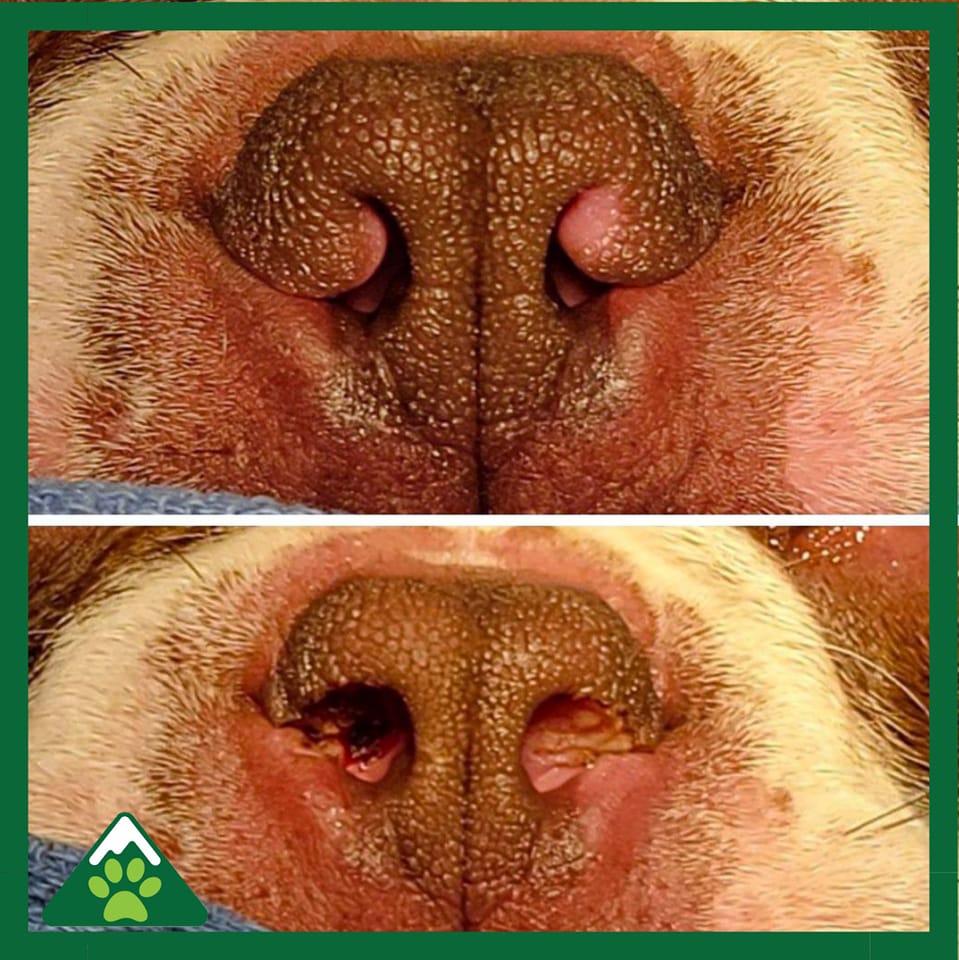BOAS Surgery
Brachycephalic Obstructive Airway Syndrome
Brachycephalic obstructive airway syndrome is a term that describes a set of anatomical features in a dog’s airway that cause increased resistance to the movement of air. It refers to dogs with shortened skull features including a shortened snout. Over time, we (humans), have bred certain breeds of dogs to have the cute, endearing, compact face that we all know and love in dogs such as French bulldogs, Pugs, Boston Terriers, English Bulldogs, etc.
Although they are adorable, the anatomy of their nose, airway, and throat can pose significant problems with breathing, especially during activity or warm weather. Noticeable signs of dogs with an affected airway consist of snoring, gagging, snorting, sleep apnea, collapse, cyanosis (bluish color to the tongue), vomiting, regurgitation, and difficulty exercising despite a willingness to exercise.
Over time, we have come to consider these signs “normal” and “expected” for these breeds of dogs, which leaves many undiagnosed and untreated. The reality is that it is never “normal” for any breed of dog to have audible noises like snorting/gagging when doing a simple task such as short walks outside, vomiting/choking after eating/drinking, or snoring so loudly, the household is disturbed! Fortunately, options do exist to help improve the quality of life for these animals if their signs are recognized and addressed appropriately.

Airway Changes To Look Out For
Brachycephalic Obstructive Airway syndrome or BOAS is comprised of 5 classic airway changes. Dogs may have one or multiple of these changes.

Stenotic Nares
Small or inverted nostrils, that limit air movement through the nose.

Elongated or Thick Soft Palate
Extra long/thick tissue that hangs down in the back of the throat that causes gagging, breathing noises.

Everted Laryngeal Saccules
“Balloon” type structures that extend outwards in the throat area that limits air movement and can cause noisy breathing.

Hypoplastic Trachea
Smaller than normal trachea or air tube leading to the lungs. This is important as it is not correctable with surgery and if present, means airflow will always be restricted to some degree. This is more common in English bulldogs.

Laryngeal Collapse
Weakness of the cartilage near the Adam’s apple. Other factors, not on this list that are associated with BOAS in some breeds include neck girth ratio (neck width), body condition score/obesity (body weight), nasopharyngeal abnormalities (20% of dogs), and bronchial collapse (87% of dogs, collapse of small airways in the lungs).
Treatment Options For BOAS
In addition to these airway changes, dogs can also have abdominal issues consisting of salivation, vomiting, and regurgitation. It has been shown that up to nearly 80% of dogs with brachycephalic syndrome have gastrointestinal changes consisting of acid reflux, hiatal hernia, pyloric stenosis, and stomach/esophageal inflammation, which is secondary to the changes in pressure created by the abnormal airway. Many of these dogs vomit regularly. When their airway resistance is corrected with surgery, the abdominal signs tend to improve as well.
Surgical intervention is often needed to help correct airway abnormalities. The surgery is best performed before the dog is in a respiratory crisis. It is recommended that the severely affected dogs have surgical correction as young as 4-6 months of age. If there are corrections made early in life there is a decreased chance of more severe airway and gastrointestinal issues developing later in life.
After 2 weeks of recovery, it is expected that dogs will have a significant improvement in their signs or even resolution of some symptoms such as sleep apnea, snorting etc. It is important to remember that due to breeding, we can never make them completely normal like a dog with a longer snout, however, we can improve their ability to breathe, dramatically improving their quality of life and improve their ability to exercise. It is important to keep these animals in good physical condition throughout their life, as any obesity will put pressure on their chest and neck and can exacerbate their signs.
